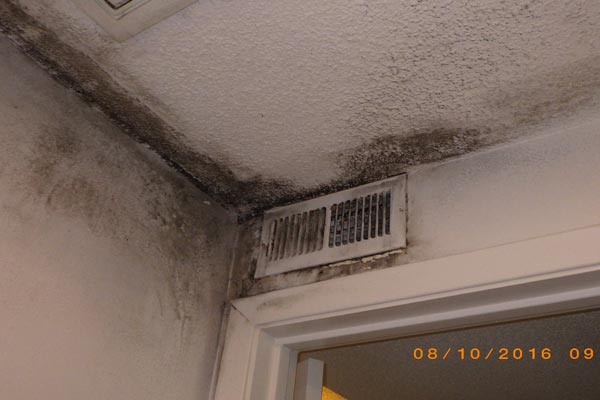How To Remove Mold
- Air Quality Test – The first step to properly removing mold is to get an air quality professional (Industrial Hygienist) to test the affected areas. With the test results the air quality professional will be capable of writing up a protocol on how to remove the mold in your home.
- Mold Containment – When mold spores get airborne, it can get in the HVAC system and spread to other parts of the building. Proper containment is extremely important in preventing the spread of contaminants. Symptoms for exposure to mold can include;
- Nasal and sinus congestion
- Eye irritation, such as itchy, red, watery eyes
- Wheezing and difficulty breathing
- Cough
- Throat irritation
- Skin irritation, such as a rash
- Headache
3. Mold Removal – Once containment is set up and the moisture source has been properly taken care of, we can begin removal. This procedure will depend on the protocol written by the air quality professional after testing. This may include removal of drywall, carpeting, ceiling tiles, etc.
Once all affected material is removed, the process of cleaning is written by the industrial hygienist but the cleaning process typically involves;
- HEPA Vacuum
- Hand Wipe Down w/ anti microbial solution.
- HEPA Vacuum
4. Mold Damage Repair – Once all the affected building materials have been properly removed and disposed of, and the area has been clean, First Restoration Services can repair all damage back to its original condition.
How To Kill Mold
You can’t “kill” mold. The mold spores can only go dormant if it doesn’t have the right nutrients (food, water, warmth and oxygen) which basically means it won’t be releasing any mycotoxins. The best way to prevent mold from growing and releasing mycotoxins remove one of these four nutrients and keep all surfaces clean, dry and plenty of ventilation.
What Does Mold Need To Grow
Mold needs four things to grow.
- Food – organic materials such as paper, wood, plants, etc.
- Temperature – The optimal temperature for mold is between 60-80 degrees Fahrenheit. This also happens to be the optimal human comfort level for temperature.
- Moisture – Mold needs a source of water to thrive and grow
- Oxygen – Mold need oxygen in order to thrive and grow.

IICRC S520 Standard
First Restoration Services follows the standard of care by the IICRC. The ANSI/IICRC S520 is a procedural standard for the remediation of mold damaged structures and contents. The ANSI/IICRC S520 is based on reliable remediation and restoration principles, research and practical experience, and attempts to combine essential academic principles with practical elements of water damage restoration for technicians facing “real-life” mold remediation challenges.
 Emergency
Emergency Residential Restoration
Residential Restoration Commercial
Commercial Water Removal
Water Removal Water Damage
Water Damage Water Damage Repairs
Water Damage Repairs Flood
Flood Sewage Cleanup
Sewage Cleanup Fire Board
Fire Board Fire Damage
Fire Damage Commercial Water Damage
Commercial Water Damage Commercial Fire Damage
Commercial Fire Damage Mold Inspection
Mold Inspection Mold Removal
Mold Removal Wind
Wind TOMI
TOMI Case
Case Helpful
Helpful ERP Client
ERP Client Construction
Construction Kitchen
Kitchen Bathroom
Bathroom Home
Home Office
Office Book Remodel
Book Remodel About
About Contact Us
Contact Us Our Story
Our Story Events
Events FRS Team
FRS Team Media
Media FAQ
FAQ Apply Now
Apply Now Careers
Careers Plumber Referral
Plumber Referral All Posts
All Posts Cleaning
Cleaning Commercial
Commercial Schools & Colleges
Schools & Colleges Churches
Churches Healthcare Facilities
Healthcare Facilities Senior Living Homes
Senior Living Homes Government Municipalities
Government Municipalities Hospitality
Hospitality Industrial
Industrial Multi-Family Housing
Multi-Family Housing Emergency Services
Emergency Services
